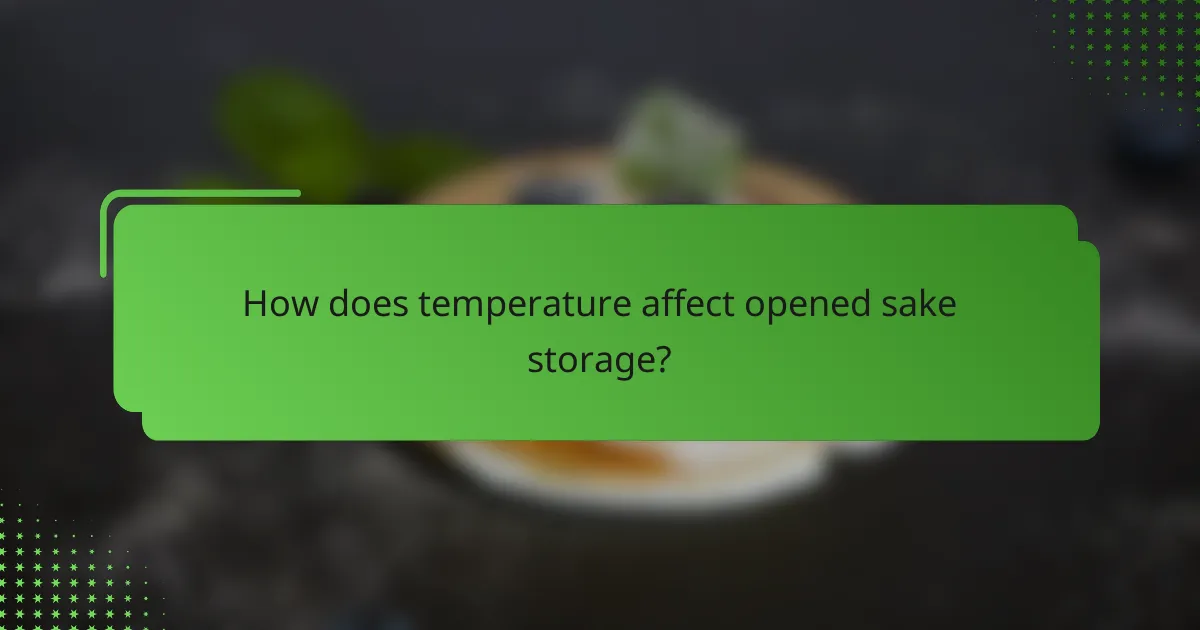Opened sake can be enjoyed for up to one week when refrigerated and up to three days at room temperature, depending on the type and sealing method. Proper storage is crucial to preserve its flavor and aroma, making it essential to follow best practices. For those looking to store sake long-term, varieties like Junmai and Ginjo are ideal due to their resilience against spoilage.

How long can opened sake be stored?
Opened sake can typically be stored for up to one week in the refrigerator and up to three days at room temperature. The storage duration depends on factors like the type of sake and how well it is sealed after opening.
Up to one week in the refrigerator
When stored in the refrigerator, opened sake can maintain its quality for about a week. The cool temperature slows down oxidation, helping preserve the flavors and aromas.
To maximize freshness, ensure the bottle is tightly sealed. Using a vacuum pump or transferring sake to a smaller bottle can help reduce air exposure.
Up to three days at room temperature
If you choose to store opened sake at room temperature, aim to consume it within three days. Warmer temperatures accelerate oxidation, which can lead to a decline in taste and quality.
Keep the bottle in a cool, dark place away from direct sunlight. Always reseal the bottle tightly after pouring to minimize air contact.

What are the best practices for storing opened sake?
To maintain the quality of opened sake, it is essential to store it properly. Following best practices can help extend its shelf life and preserve its flavor and aroma.
Keep sake in a cool, dark place
Storing sake in a cool, dark environment is crucial for preserving its quality. Ideal temperatures range from 5°C to 15°C (41°F to 59°F). Avoid exposure to direct sunlight and heat sources, as these can degrade the sake’s flavor over time.
Consider using a dedicated wine fridge or a dark cupboard for optimal storage. Regular refrigerators can also work but may be too cold for some types of sake, so monitor the temperature closely.
Use an airtight container
Using an airtight container is vital to prevent oxidation, which can spoil the sake. Once opened, transfer the sake to a bottle with a tight-sealing cap or a vacuum-sealed container to minimize air exposure.
If the original bottle is not resealable, consider using a smaller bottle to limit the air space. This practice helps maintain the sake’s freshness and flavor for a longer period.

What types of sake are best for long-term storage?
For long-term storage, Junmai and Ginjo sake are among the best options. These types are less susceptible to spoilage and can maintain their quality over extended periods when stored properly.
Junmai sake
Junmai sake is made from pure rice and water, without any added alcohol or sugars. This type typically has a rich, full-bodied flavor that can develop complexity over time, making it suitable for long-term storage.
When storing Junmai, keep it in a cool, dark place, ideally at temperatures between 10°C and 15°C (50°F and 59°F). Proper storage can enhance its flavor profile, allowing it to age gracefully for several years.
Ginjo sake
Ginjo sake is crafted with rice polished to at least 60% of its original size, resulting in a lighter and more fragrant profile. While it is generally best consumed fresh, high-quality Ginjo can still be stored for a moderate duration if kept under optimal conditions.
To store Ginjo sake effectively, maintain a consistent temperature around 5°C to 10°C (41°F to 50°F) and avoid exposure to light. This careful approach can help preserve its delicate aromas and flavors for up to a couple of years.

How does temperature affect opened sake storage?
Temperature plays a crucial role in opened sake storage, influencing its flavor and longevity. Keeping sake at the right temperature can help maintain its quality and prevent spoilage.
Optimal storage temperature is 5-10°C
The ideal storage temperature for opened sake is between 5 and 10 degrees Celsius. This range helps preserve the delicate flavors and aromas that are characteristic of sake. A refrigerator is a suitable place for storage, as it maintains a consistent cool temperature.
When storing sake, ensure it is sealed properly to minimize exposure to air, which can alter its taste. Using a vacuum pump or tightly sealing the bottle can help maintain the quality during storage.
Higher temperatures accelerate spoilage
Storing opened sake at higher temperatures can lead to rapid spoilage, resulting in off-flavors and a decrease in overall quality. Temperatures above 10 degrees Celsius can significantly shorten the shelf life of sake, often leading to noticeable changes within days.
Avoid placing opened sake near heat sources, such as ovens or direct sunlight, as these conditions can exacerbate spoilage. If you notice any changes in aroma or taste, it’s best to discard the sake to avoid an unpleasant drinking experience.

What are the signs of spoiled sake?
Spoiled sake can exhibit several noticeable signs that indicate it is no longer safe to consume. Common indicators include off odors and cloudiness or sediment in the liquid, which can affect both the flavor and quality of the sake.
Off odors
One of the primary signs of spoiled sake is the presence of off odors. Fresh sake typically has a clean, fruity aroma, while spoiled sake may emit sour, vinegar-like, or musty smells. If you detect any unpleasant or unusual scents, it’s best to discard the sake.
These off odors often result from oxidation or bacterial contamination. Sake that has been improperly stored or kept for too long can develop these undesirable characteristics, making it unpalatable.
Cloudiness or sediment
Cloudiness or sediment in sake is another clear sign of spoilage. While some unfiltered sake varieties may naturally have a cloudy appearance, any unexpected cloudiness in filtered sake indicates potential spoilage. This can occur due to the growth of bacteria or yeast after opening.
If you notice sediment at the bottom of the bottle that wasn’t present before, it may suggest that the sake has deteriorated. In such cases, it’s advisable to avoid consuming the sake, as it may not be safe.

What containers are suitable for storing opened sake?
Opened sake should be stored in containers that minimize exposure to air and light, preserving its flavor and quality. Suitable options include glass bottles and vacuum-sealed bags, each offering unique benefits for maintaining the sake’s integrity.
Glass bottles
Glass bottles are a popular choice for storing opened sake due to their non-reactive nature. They effectively prevent chemical reactions that can alter the taste of the sake, especially when kept in a cool, dark place.
When using glass bottles, ensure they are tightly sealed to limit air exposure. It’s best to transfer the sake into a smaller bottle if the original container is large and only partially filled, as this reduces the air space and helps maintain freshness.
Vacuum-sealed bags
Vacuum-sealed bags are an innovative option for storing opened sake, as they remove air and create a tight seal around the liquid. This method is particularly effective for longer storage periods, as it significantly slows down oxidation.
To use vacuum-sealed bags, pour the sake into the bag, seal it according to the manufacturer’s instructions, and store it in a cool environment. This method is ideal for those who want to preserve the sake’s quality for weeks or even months. However, ensure the bag is made from food-safe materials to avoid any contamination.

How to properly serve opened sake?
To properly serve opened sake, ensure it is stored correctly and served at the right temperature. Sake can be enjoyed chilled, at room temperature, or warmed, depending on the type and personal preference.
Temperature considerations
The temperature at which sake is served significantly affects its flavor profile. Generally, premium sakes are best enjoyed chilled, while some lower-grade varieties can be served warm. Aim for a serving temperature between 5°C to 15°C for chilled sake and around 40°C to 50°C for warmed sake.
Glassware selection
Selecting the right glassware enhances the sake experience. Traditional ochoko (small ceramic cups) or masu (wooden boxes) are popular choices. For premium sakes, consider using a wine glass to allow for better aroma and flavor appreciation.
Serving methods
When serving opened sake, pour it gently to avoid excessive aeration. Fill the glass to about 70-80% full to allow room for aromas. If serving multiple guests, consider a communal pouring style from a tokkuri (sake carafe) to enhance the social aspect of the experience.
Storage after opening
After opening, sake should be stored in a cool, dark place, ideally in the refrigerator. Consume opened sake within a week or two for the best flavor, as exposure to air can lead to oxidation and a decline in quality.










